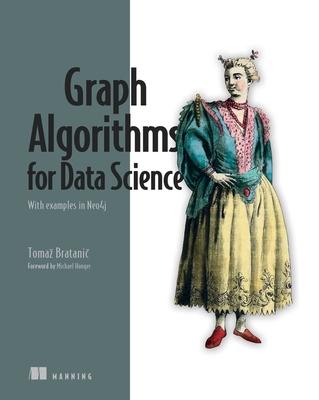- Labeled-property graph modeling
- Constructing a graph from structured data such as CSV or SQL
- NLP techniques to construct a graph from unstructured data
- Cypher query language syntax to manipulate data and extract insights
- Social network analysis algorithms like PageRank and community detection
- How to translate graph structure to a ML model input with node embedding models
- Using graph features in node classification and link prediction workflows
Graph Algorithms for Data Science is a hands-on guide to working with graph-based data in applications like machine learning, fraud detection, and business data analysis. It's filled with fascinating and fun projects, demonstrating the ins-and-outs of graphs. You'll gain practical skills by analyzing Twitter, building graphs with NLP techniques, and much more. Foreword by Michael Hunger. Purchase of the print book includes a free eBook in PDF, Kindle, and ePub formats from Manning Publications. About the technology A graph, put simply, is a network of connected data. Graphs are an efficient way to identify and explore the significant relationships naturally occurring within a dataset. This book presents the most important algorithms for graph data science with examples from machine learning, business applications, natural language processing, and more. About the book Graph Algorithms for Data Science shows you how to construct and analyze graphs from structured and unstructured data. In it, you'll learn to apply graph algorithms like PageRank, community detection/clustering, and knowledge graph models by putting each new algorithm to work in a hands-on data project. This cutting-edge book also demonstrates how you can create graphs that optimize input for AI models using node embedding. What's inside
- Creating knowledge graphs
- Node classification and link prediction workflows
- NLP techniques for graph construction
About the reader For data scientists who know machine learning basics. Examples use the Cypher query language, which is explained in the book. About the author Tomaz Bratanic works at the intersection of graphs and machine learning. Arturo Geigel was the technical editor for this book. Table of Contents PART 1 INTRODUCTION TO GRAPHS
1 Graphs and network science: An introduction
2 Representing network structure: Designing your first graph model
PART 2 SOCIAL NETWORK ANALYSIS
3 Your first steps with Cypher query language
4 Exploratory graph analysis
5 Introduction to social network analysis
6 Projecting monopartite networks
7 Inferring co-occurrence networks based on bipartite networks
8 Constructing a nearest neighbor similarity network
PART 3 GRAPH MACHINE LEARNING
9 Node embeddings and classification
10 Link prediction
11 Knowledge graph completion
12 Constructing a graph using natural language processing technique
